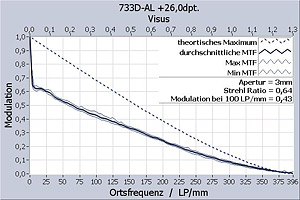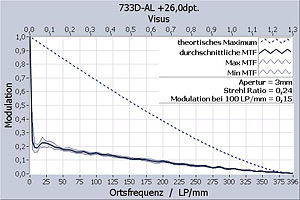Imaging quality of multifocal (bifocal) IOLs
Explanations
The measurement results of bifocal or multifocal intraocular lenses (IOL) are listed below. All measurements are carried out using the measuring stand developed at the Institute in accordance with EN/ISO 11979-2 [ISO11979]. In accordance with ISO, the IOL to be tested is operated under in vivo-like conditions within an artificial eye in a water bath that simulates the rest of the eye (cornea and aqueous humor).
Each lens is generally measured in two refractive powers (usually +13dpt. and +26dpt, or the closest value provided by the manufacturer) in order to visualize the effects of spherical aberrations. A graph of the measured MTF and the value of the Strehl ratio (comparison between measured IOL and diffraction-limited ideal IOL) as well as the ISO criterion (modulation at 100 line pairs/mm) are listed for each measured lens. Explanations of the following graphs can be found under quality criteria.
Special features of bifocal IOLs
In order to reproduce the accommodation of the natural lens (adjustment of its refractive power to the distance of the object being viewed to enable near or distance vision), multifocal IOLs have several focal points. In the case of IOLs, this is usually two focal points, which is why they are also referred to as bifocal lenses. Accordingly, two focal areas (e.g. focal plane at 50 cm and focus at a distance of more than 5 m from the object) can be focused simultaneously.
This ability comes at the cost of the other image plane also being out of focus at the same time. In the PSF, this is reflected in a significantly increased amount of stray light (halo) around the primary focus point. As the energy of the respective blurred focus is distributed over a comparatively large area, the values increase significantly at low spatial frequencies (value 0 and 1). The intensities of the two foci are often divided asymmetrically (e.g. 70% to 30%) to support the image-processing neuronal network of the brain, which leads to two differently pronounced control light components and thus to differently increased peaks at spatial frequency = 0 [Akutsu93].
For the above reasons, the imaging quality of bifocal IOLs is poorer than that of an optimal monofocal lens. With modern bifocal designs, however, it is quite comparable to that of a monofocal lens with significant spherical aberration, especially at higher refractive powers.
List of IOLs examined
| IOL manufacturer | IOL type | Measured refractive power |
| *Acri.Tec | *Acri.Stil.Twin 733D (Twinset) | +26dpt. |
Detailed measurement results
Acri.Tec - *Acri.Stil.Twin 733D
| 733D near focus, 26dpt. | 733D distance focus, +26dpt. |
 |
 |
| Strehl ratio: 0.64 ISO criterion: 0.43 Energy content: 70% |
Strehl ratio: 0.24 ISO criterion: 0.15 Energy share: 30% |
Contact
Prof. Dr. rer.nat. Wilhelm Stork
Tel. 0721 / 608 - 42510, wilhelm.stork∂kit.edu

